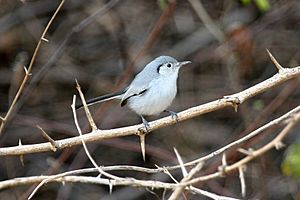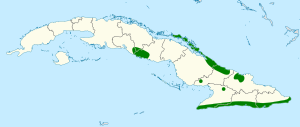Cuban gnatcatcher facts for kids
Quick facts for kids Cuban gnatcatcher |
|
|---|---|
 |
|
| Conservation status | |
| Scientific classification | |
| Genus: |
Polioptila
|
| Species: |
lembeyei
|
 |
|
The Cuban gnatcatcher (Polioptila lembeyei) is a small bird that belongs to the gnatcatcher family. It is a special bird because it lives only in Cuba. This means it is endemic to the island.
Contents
About the Cuban Gnatcatcher
Who Named This Bird?
A famous scientist named Juan Gundlach described the Cuban gnatcatcher. He was a naturalist who lived in Cuba. He named the bird to honor his friend, Juan Lembeye.
Is it a Unique Bird?
Yes, the Cuban gnatcatcher is a unique species. It is the only type of its kind, which means it is "monotypic."
What Does It Look Like?
The Cuban gnatcatcher is a very small bird. It is about 10 to 11 cm (3.9 to 4.3 in) long. This is about the length of a pen. It weighs only 4.5 to 5 g (0.16 to 0.18 oz). That's lighter than a single coin!
Male and Female Birds
Male Cuban gnatcatchers have blue-gray feathers on their backs. Their undersides are white. They have a special black mark behind their eyes. This mark looks like a crescent moon. They also have a long black tail with white feathers on the sides.
Female birds look similar to males. However, their colors are a bit lighter. Their black facial mark is also thinner.
Young Birds
Young Cuban gnatcatchers look different from adults. They are olive-gray on top. Their sides are a light brown color. Their bellies are creamy white. They have only a very faint facial mark.
Where Does It Live?
The Cuban gnatcatcher lives in Cuba. You can find it along many parts of the north and southeast coasts. It also lives in some separate areas along the south coast.
Its Home Environment
This bird prefers dry, scrubby areas. These places are called "xeric scrubland." They are often found in areas below 100 m (330 ft) in height.
How Does It Behave?
What Does It Eat?
Scientists believe the Cuban gnatcatcher eats small insects and spiders. It is very active when it looks for food. It searches among the lower branches of plants and bushes.
How Does It Raise Its Young?
The breeding season for the Cuban gnatcatcher is from March to July. Both the male and female birds work together. They build a deep, cup-shaped nest. They use hair, plant fibers, and small leaves. They line the nest with soft materials.
The nest usually hangs from a small branch. It is often in a spiny bush. The nest can be up to 6.4 m (21 ft) above the ground. A female bird usually lays three eggs. Sometimes they lay two to five eggs. Raising young birds can be tough for them.
What Does Its Song Sound Like?
The Cuban gnatcatcher has a unique song. It is a long, rambling sound. It includes warbles, whistles, and chattering notes. You can listen to it online.
Is It in Danger?
The IUCN (International Union for Conservation of Nature) checks on animals. They have listed the Cuban gnatcatcher as "Least Concern." This means it is not currently in great danger.
However, its home is special. Its habitat is considered vulnerable. This means it could be harmed by grazing animals or by land being used for other things.
See also
 In Spanish: Polioptila lembeyei para niños
In Spanish: Polioptila lembeyei para niños


